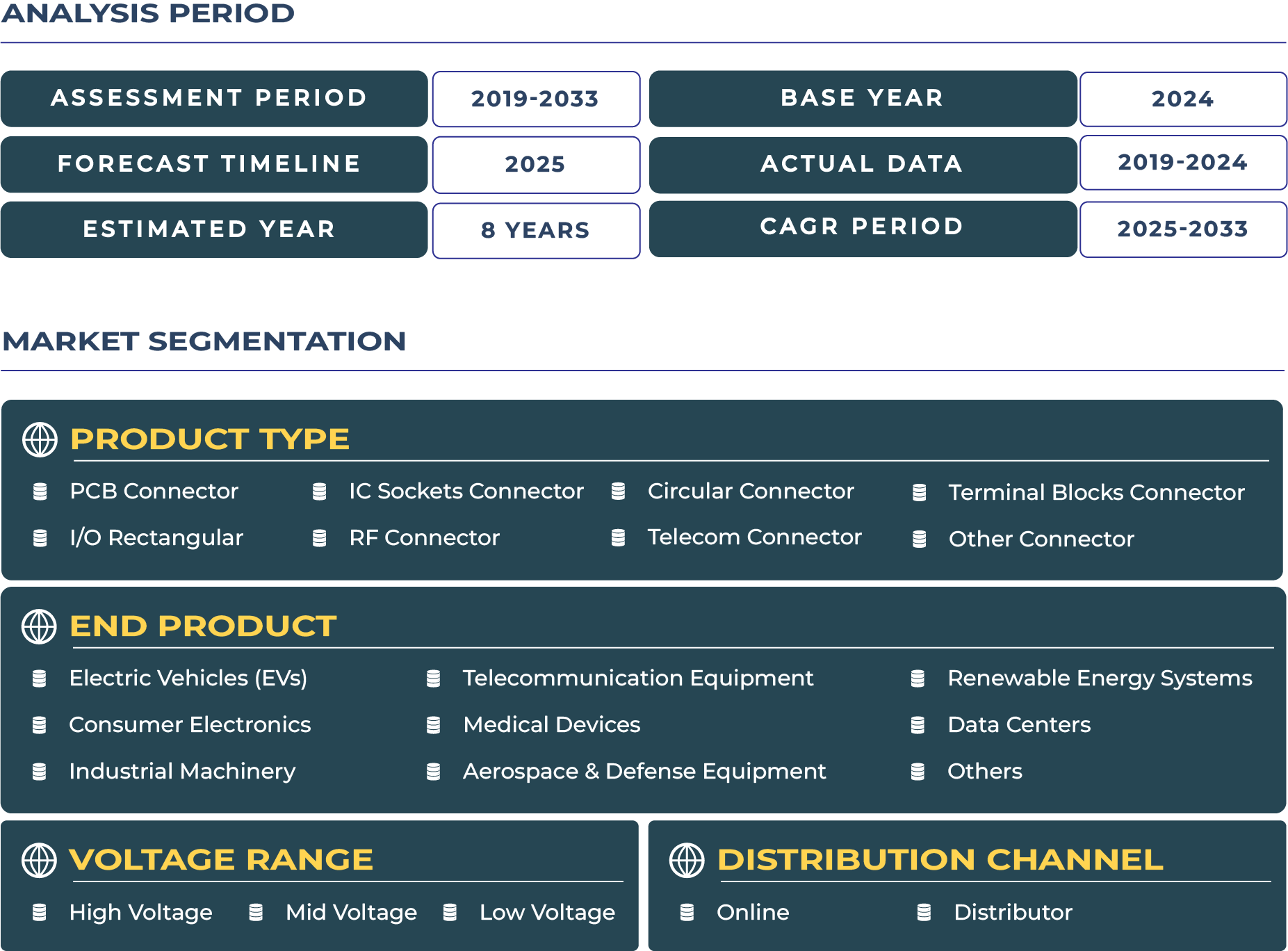China Connector Market Outlook
High‑Reliability & Military‑Grade Connectivity: The Foundation of China’s Next‑Gen Industrial Evolution
In China’s ongoing march toward industrial eminence, connectors serve as the unsung enablers of quantum‑level performance. In sectors ranging from semiconductor fabrication to military and telecom systems, demand for high‑reliability and shielded connectivity has surged. The impetus stems from rapid innovation in semiconductor packaging—chiplet architectures, fan‑out wafer‑level packaging, and increased I/O density—and a heightened focus on military‑grade communications infrastructure. This confluence is driving demand for connectors with robust EMI/RFI shielding, photonic capabilities, and hybrid telecom‑military interoperability. China connector ecosystem is projected to reach USD 79.5 billion by 2033, reflecting a CAGR of 7.5% from 2025 to 2033. Such expansion is underpinned by investment in shielded PCB connectors, fiber‑optical interconnects, and rugged circular/connectors for defense applications.
Semiconductor Packaging Complexity & Military Modernization: The Twin Engines Driving Growth
China connector market is being propelled by two powerful forces: increasing semiconductor packaging complexity and military communications upgrades. First, the proliferation of multi‑chip modules and heterogeneous integration necessitates connectors with high pin‑density, low parasitic inductance, and exceptional signal integrity. PCB+I/O rectangular connectors form the backbone here, supporting chiplet‑based processors and advanced memory systems. Second, the Chinese military’s pivot toward secure, high‑frequency communications and electronic warfare systems is accelerating demand for RF coaxial connectors and optical interconnects. Increased procurement of photonic links for command‑and‑control and satellite systems underscores this, necessitating connectors that simultaneously address EMI/RFI suppression and secure data transmission.
Design Obsolescence & Thermal Constraints: Challenges Threatening Market Momentum
Despite strong demand drivers, the connector sector faces notable impediments. The accelerated obsolescence cycle of connector design—driven by technology turnover in 5G, semiconductors, and autonomous systems—forces manufacturers into frequent redesigns, inflating R&D and qualification costs. Moreover, the rise of high‑density board layouts leads to serious heat dissipation issues. Connectors operating at high current or data rates in restricted form factors generate localized thermal hotspots, requiring thermal‑management solutions at the connector level. These require additional materials, coatings, or heat‑sink integration, which drive up prices and extend lead times. Together, design churn and thermal challenges pose significant cost pressures and can restrict adoption in cost-sensitive OEM environments.
Optical & Photonic Interconnect Surge & EMI/RFI Imperatives: Emerging Market Trends
Two prominent trends are reshaping China connector ecosystem. First, optical and photonic interconnects are gaining traction across data centers and telecom gear. Driven by terabit-switch adoption and metro‑edge deployments, fiber‑optic and photonic connectors are becoming standard for high‑speed rack and board‑to‑fiber applications. Second, the proliferation of high‑density electronics in smartphones, EVs, and infrastructure is imposing strict EMI/RFI shielding requirements. Shielded PCB connectors, circular rugged connectors, and coax assemblies are being integrated early into design, acting as part of system‑level EMI solutions. These trends reflect a broader shift toward connectors functioning as integrated signal‑integrity/security components, not just mechanical junctions.
Quantum & Defense‑Grade Optical Connectors: Portals to Future Opportunities
China's push into quantum computing and terabit‑class communications has created fertile ground for next‑generation connector opportunities. The development of optical fiber connectors compatible with quantum key distribution (QKD) networks is underway. Equally, shielded connectors tailored for extreme-environment deployment in defense, aerospace, and telecom systems present growth avenues. Suppliers capable of delivering certified MIL‑STD optical and electromagnetic shielding performance stand to capture premium pricing and long‑term contracts, particularly in dual-use applications.
Regulatory Momentum & Domestic Technology Push: Government Policies Fueling Upgrades
China’s Ministry of Industry and Information Technology (MIIT), through policies outlined in its 2024 green manufacturing action plan, is driving adoption of domestic, high-efficiency connector standards in greenfield fabs. This has stimulated demand for connectors meeting both signal and power delivery efficiency criteria in compliance with MIIT’s thresholds. In telecom, national standards for ruggedized EMI/RFI‑compliant connectors in 5G macro and micro‑base stations are catalyzing local supplier development. These policy measures are accelerating market maturation toward connectors with certified shielding and thermal performance.







